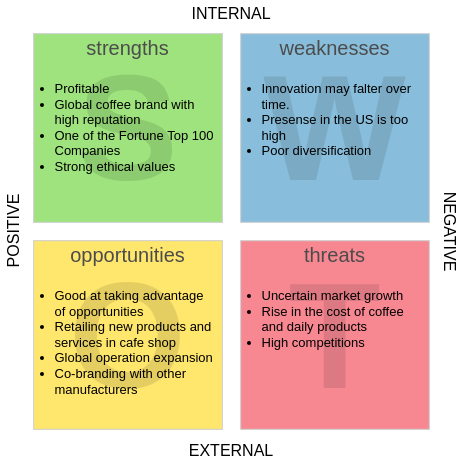SWOT Analysis: A Comprehensive Guide
What is SWOT Analysis?
SWOT Analysis is a strategic planning tool used to identify and evaluate the Strengths, Weaknesses, Opportunities, and Threats related to a business or project. This framework helps organizations understand internal and external factors that can impact their success and inform strategic decision-making.
(Create a SWOT Analysis Chart Instantly)

Why Use SWOT Analysis?
- Strategic Planning: Provides a structured approach to assess the current situation and plan for the future.
- Decision Making: Helps in making informed decisions by highlighting critical factors.
- Resource Allocation: Aids in identifying where to focus resources for maximum impact.
- Risk Management: Identifies potential risks and challenges, enabling proactive management.
How to Conduct a SWOT Analysis
Steps to Perform SWOT Analysis
- Gather a Team: Involve diverse members from different departments to provide varied perspectives.
- Brainstorm: Encourage open discussion to identify strengths, weaknesses, opportunities, and threats.
- List Factors: Write down all identified factors in their respective categories.
- Prioritize: Rank the items based on their significance to the organization.
- Develop Strategies: Formulate actionable strategies that leverage strengths and opportunities while addressing weaknesses and threats.
Guidelines for Conducting SWOT Analysis
- Be Honest: Ensure that the analysis is realistic and candid.
- Focus on Key Factors: Avoid listing trivial items; concentrate on significant elements that impact the business.
- Use Data: Support your analysis with data and evidence where possible.
- Review Regularly: SWOT analysis should be updated periodically to reflect changes in the business environment.
Tips & Tricks
- Visualize the Matrix: Create a visual SWOT matrix to easily see the relationships between different factors.
- Involve Stakeholders: Engage stakeholders in the process to gain insights and buy-in.
- Consider Future Trends: Think about how emerging trends may affect your SWOT factors.
- Actionable Insights: Ensure that the outcomes of the analysis lead to clear, actionable strategies.
Example SWOT Analysis
Strengths (Internal, Positive)
- Profitable: The company demonstrates strong financial performance.
- Global Coffee Brand with High Reputation: Well-known and respected in the coffee industry.
- One of the Fortune Top 100 Companies: Recognized as a leading player in the market.
- Strong Ethical Values: Commitment to ethical sourcing and sustainability enhances brand loyalty.
Weaknesses (Internal, Negative)
- Innovation May Falter Over Time: Risk of stagnation if new products and ideas are not consistently developed.
- Presence in the US is Low: Limited market penetration in a key region.
- Poor Diversification: Over-reliance on specific products may expose the company to market volatility.
Opportunities (External, Positive)
- Good at Taking Advantage of Opportunities: Ability to capitalize on market trends and consumer preferences.
- Retailing New Products and Services in Café Shops: Expanding product offerings can attract more customers.
- Global Operation Expansion: Opportunities to enter new markets and increase market share.
- Co-branding with Other Manufacturers: Potential partnerships can enhance brand visibility and reach.
Threats (External, Negative)
- Uncertain Market Growth: Economic fluctuations may impact sales and profitability.
- Rise in the Cost of Coffee and Daily Products: Increased costs can squeeze margins and affect pricing strategies.
- High Competition: Intense rivalry in the coffee industry can lead to price wars and reduced market share.
Conclusion
SWOT analysis is a powerful tool for strategic planning and decision-making. By systematically evaluating the internal and external factors influencing a business, organizations can develop strategies that capitalize on strengths and opportunities while addressing weaknesses and threats. Regularly revisiting the SWOT analysis ensures that the business adapts to changing market conditions and remains competitive.
This case study of Starbucks serves as a learning tool for understanding the application of SWOT analysis in a real-world context. While it highlights the company’s strengths, weaknesses, opportunities, and threats, it is important to note that this analysis may not fully reflect the actual situation of Starbucks. The dynamic nature of the coffee industry means that real circumstances can vary due to market fluctuations, consumer preferences, and competitive pressures. Therefore, this example should be viewed as a hypothetical scenario designed to enhance comprehension of the SWOT framework rather than a definitive assessment of the company’s current status.


